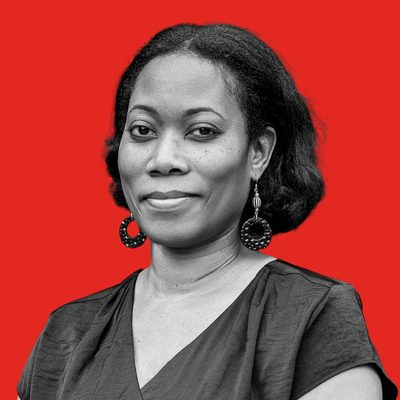Public Wailing as Political Dissent
Both personal and political, wailing disrupts the social order.
Renee Simms

This piece was adapted from an essay originally published in Guernica magazine.
I hadn’t thought much about public wailing before my uncle’s funeral. His sudden death from a heart attack in 1990 shocked our community, because for many people Uncle F’s life seemed immune to tragedy. He was the kind of 20th-century man for whom even Blackness seemed a noble grace. His chiseled features made him resemble the actor Percy Rodriguez, who played Commodore Stone in the original Star Trek series. And he wasn’t old when his heart stopped, but robustly middle-aged and at the peak of a prominent legal career. Uncle F and his second wife lived in a Michigan suburb, in a nice house with their young kids. Then he was found unresponsive on the couch.
I remember the moment my auntie began wailing at his funeral. She was my uncle’s disgraced first wife. For over an hour she’d sat among the mourners in the Episcopal church on West Seven Mile Road, listening to the somber prayers and songs. Years before, some of these mourners had known that my uncle had a white mistress; when he married her, some of them had attended the wedding. My aunt never recovered from the shame. So, when the coffin that held her ex-husband was carried down the aisle, past the second wife and the pew where auntie sat with her adult children, decades of pain and alienation exploded from her throat. It was a sharp sound in a high register, like a starling’s scream. Her cry was both personal and deeply political — reflecting the loss of a loved one as well as a long and tangled history of trauma.
Soon after my auntie started to yell, other women also began to cry out.
In 2012, I became obsessed with wailing women. This was after the death of Trayvon Martin, and then Michael Brown and then Jordan Davis. I watched the public appearances of their grieving mothers with mixed emotions. I told close friends that if one of my children were murdered by police, I would not be stoic for anyone. “Instead,” I said, “I will go mad. I will scream until I have everyone’s attention and retreat from anything resembling normalcy ever again.”
Since the police-murders of George Floyd and Breonna Taylor in the midst of a historic pandemic, I’ve had a recurring dream. I’m standing in the middle of a winding, residential street not unlike the twisting, dark roads where I live in the Pacific Northwest. I stand alone and I’m screaming. I scream until I am hoarse, at which point my screaming turns into sobs. People pull their cars onto the shoulder of the road. Some people step out of their homes. This is where the dream always ends, on the verge of assembly.
There’s a scene late in Spike Lee’s Do the Right Thing where Mother Sister (Ruby Dee) screams as her neighborhood erupts in flames. Before we get to this scene, we watch as ordinary events transpire over the course of one day. We see young people talking shit on Brooklyn stoops, eating flavored ice and staring down racist police. We witness Buggin’ Out and Radio Raheem bargain for extra cheese at Sal’s Famous Pizzeria. This is Spike Lee’s dream world: a polycultural, immigrant and working-class neighborhood populated by the underemployed and unemployed.
Lee encourages his viewers to be optimistic about this fictional Brooklyn community; his Bed-Stuy is bathed in sunlight and primary colors. This filmic grammar shapes the movie’s trope: the American neighborhood, the setting for dozens of stories about the American dream. The genius of Do the Right Thing is that it centers racism in the dream, but it does so within the context of that familiar feel-good trope. By the time police murder Radio Raheem and the looting of Sal’s begins, we understand the riot was inevitable, but we’re still sad that this ideal neighborhood could not hold.
That moment is when Mother Sister begins to wail. Her cry opens us up to feel the longue durée of a community’s suffering. She’s crying for Radio Raheem, but the depth of her emotion suggests she’s reacting to an act of genocide.
The usual occasion for public wailing is death. In his research on ritual wailing in Amerindian Brazil, anthropology professor Greg Urban found that wails capture listeners’ attention in part because they are structured like music, with “sing-song intonations” and “a pattern of parallelism.” This structure can include the repetition of words. In Do the Right Thing, Mother Sister repeats the word “no” as she wails. For my auntie, it was “It’s alright” and “You don’t have to worry anymore.” But Urban found another function to ritual wailing: communicating a desire for social connection and acceptance.
Where it still exists, public wailing is a ritual in decline. Researching ritual wailing in Yemenite-Israeli culture, anthropology and sociology professor Tova Gamliel found that young people considered it backward and embarrassing. This decline, she argues, is part of the general weakening of tradition in both Israel and Yemen. As one young Yemeni woman said, “[We’re] a generation that doesn’t recognize its God.”
In fact, you can’t understand public wailing without understanding religion. Ritual wailing is a tradition found in Judaism, Christianity and many cultures and religions across the world. The Bible includes several passages in which public cries are the prescribed response to a community’s trials, injustices or sins. The Book of Isaiah says, “Cry aloud; do not hold back; lift up your voice like a trumpet; declare to my people their transgression.” Wailing women are a frequent biblical trope. The trope appears in secular literature as well. It’s in classics like Antigone, which pre-dates the Bible. It’s in Toni Morrison’s Beloved, from 1987.
In 1955, the photograph of Mamie Till-Mobley crying out beside her 14-year-old son Emmett Till’s casket created momentum for the civil rights movement. Even in the absence of an audible cry, the published image of Mobley’s distressed face did the work that the sound of wailing can do. It communicated the depth of her suffering while moving a nation to respond.
Still, the wailing woman does seem like a relic from another time. The closest I’ve come to public lamentation myself is when I read Lucille Clifton’s poem “jasper texas 1998” at an online vigil for George Floyd and Breonna Taylor. The poem is about the 1998 lynching of James Byrd Jr., written from the perspective of the deceased Byrd. As I read it aloud on Zoom, this line sounded like a cry: “why and why and why / should i call a white man brother?” If we understand Clifton’s poem as a wail, it is striking that the wailer is a murdered man crying for himself. Why would Clifton write the poem this way? Why does a dead man speak? Clifton destabilizes our thinking about whose life is recognized, who survives and who has license to speak, when she writes, “who is the human in this place, / the thing that is dragged, or the dragger?” Her point: Historically, the definition of human has been corrupted by anti-Black racism.
Wailers disrupt the social order through the public use of their voice. They refuse to remain silent about tragedy or loss. Black feminists have long argued that the powerless become empowered through their voices, especially through expressions of emotion and desire. This is because “all systems of oppression rely on harnessing the power of the erotic,” as social theorist Patricia Hill Collins points out. The poet Audre Lorde defined “erotic” as “a measure between the beginnings of our sense of self and the chaos of our strongest feelings.” According to Lorde, when women tap into that creative power “born of Chaos,” we assert our “lifeforce” and reclaim our language, history, work — and our entire lives.
In hindsight, my aunt’s act of wailing at the funeral was an assertion of her standing within our community. She dared to speak about her love for her ex-husband when everyone wanted her silent. Despite attempts to shame her about her failed marriage, she publicly mourned her loss. Her cries proclaimed that what had been done to her had been done to all of us. By piercing the silence of the church and daring to be vulnerable, she made us feel our connection to each other. Within minutes, other mourners began openly weeping or talking, and embracing my aunt. They acknowledged her pain and belonging. Through vulnerability, she asserted her power and reestablished the communal ties that sexism and racism had torn apart.
In 1992, filmmaker Marlon Riggs described the social alienation caused by classist and geographic snobbery. “I mean, people just seem so disconnected in general,” he said two years before his death. “If you just talk to people, what goes on in New York is utterly foreign to what goes on here in California. … A school district fails in this state or in this district and it does not matter to me as long as I seem to be getting mine. … And that kind of general alienation is suicidal for a community.” For Riggs, our alienation was directly related to our inability to see our neighbors as ourselves.
Like Lorde and Collins, Riggs believed what we fear most is the chaos within ourselves. In another interview from the 1990s, he argues for a different conception of social identity, “a conceiving of self that’s not premised on ‘the other.’ … Without ‘the other’ we would have to really look at ourselves and see the chaos within.” Well, here we are in 2020, still grappling with the chaos created by white supremacy, still alienated from ourselves as well as each other.
In dealing with my own chaos, I dream of wailing in the streets. I romanticize an act of courage I witnessed inside a church. I convince myself that I don’t need to cry, that public protests will be enough. But deep down, I know neither dreams nor protests can provide the spiritual catharsis that I crave. I know that I should unleash my grief; I know I need to scream. I imagine there’s freedom in a public wail. But I can’t imagine the space or occasion where it could happen, or who I would be afterward.
In the meantime, I muddle through another day and another chat via Zoom. I read messages from my white friends who wonder how I am. What can I say? I am not fine? None of us is doing well? Without meaningful rituals or social identities not premised on “the other,” we are caught in a frightening loop called race. And it’s there that our emotions remain as unexpressed lamentations, as hard knots lodged deep in our throats.
Renee Simms’ debut story collection Meet Behind Mars was a Foreword INDIES Finalist and listed by The Root as one of 28 brilliant books by Black authors in 2018. She teaches at the University of Puget Sound and in the Rainier Writing Workshop.






